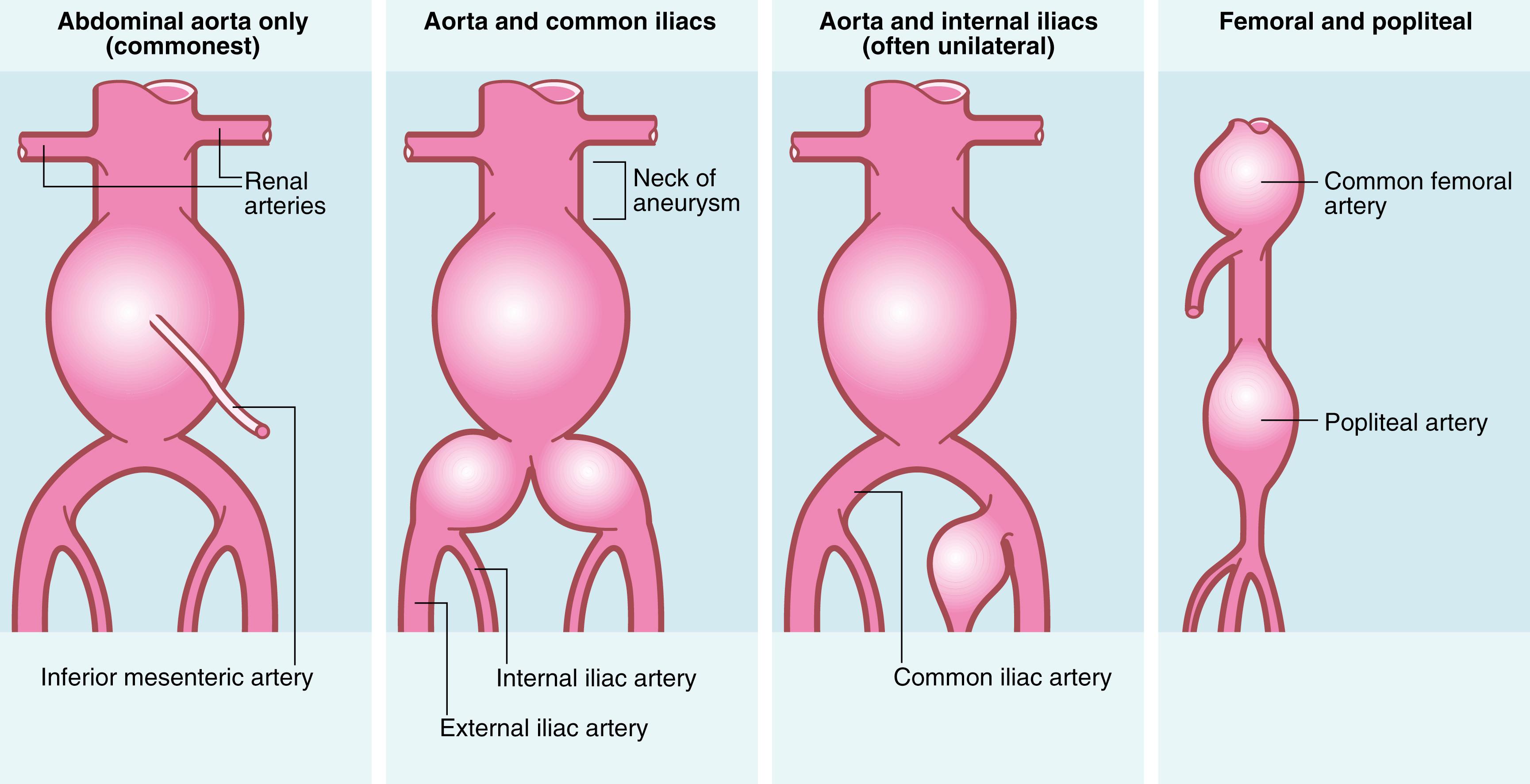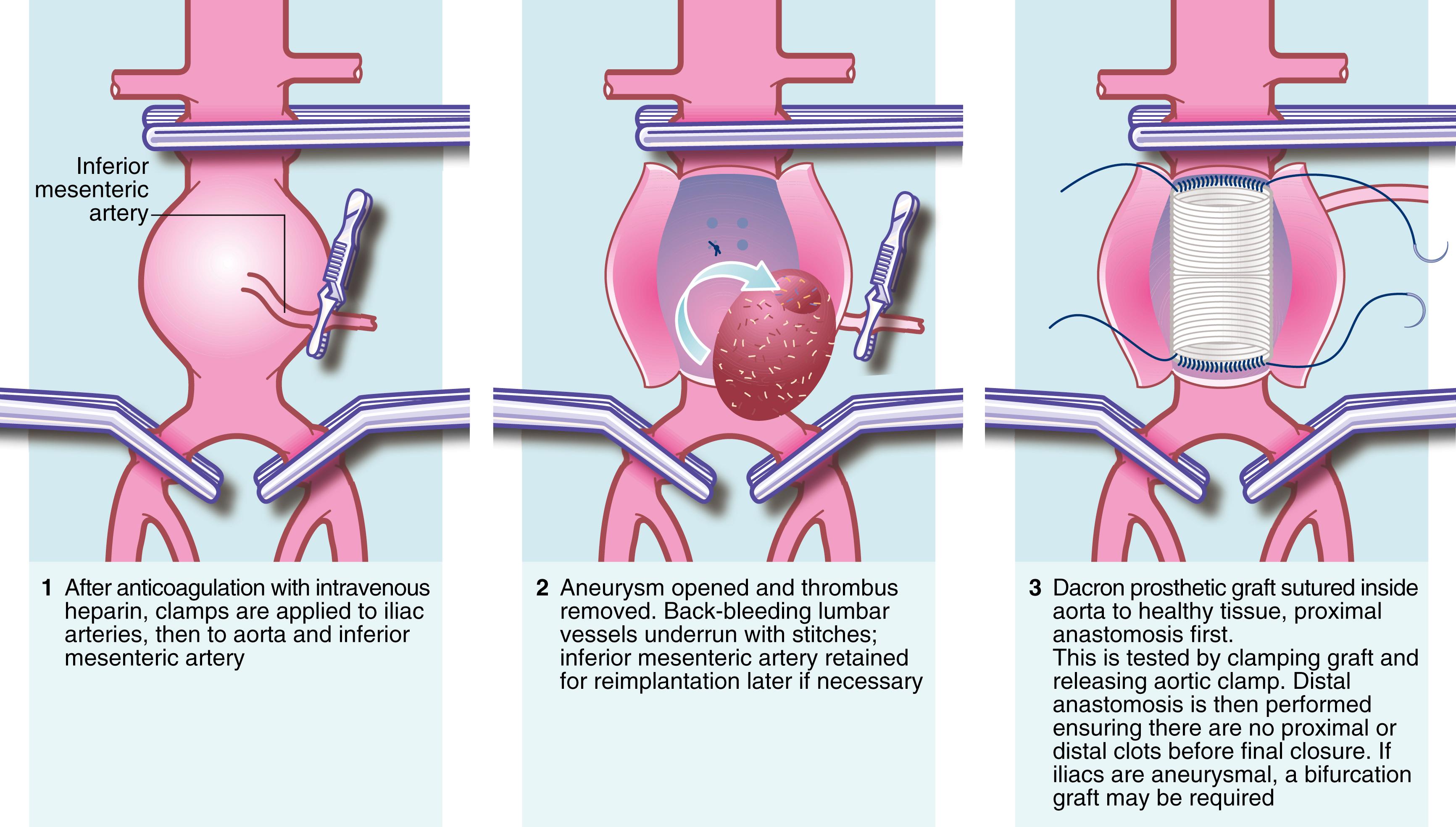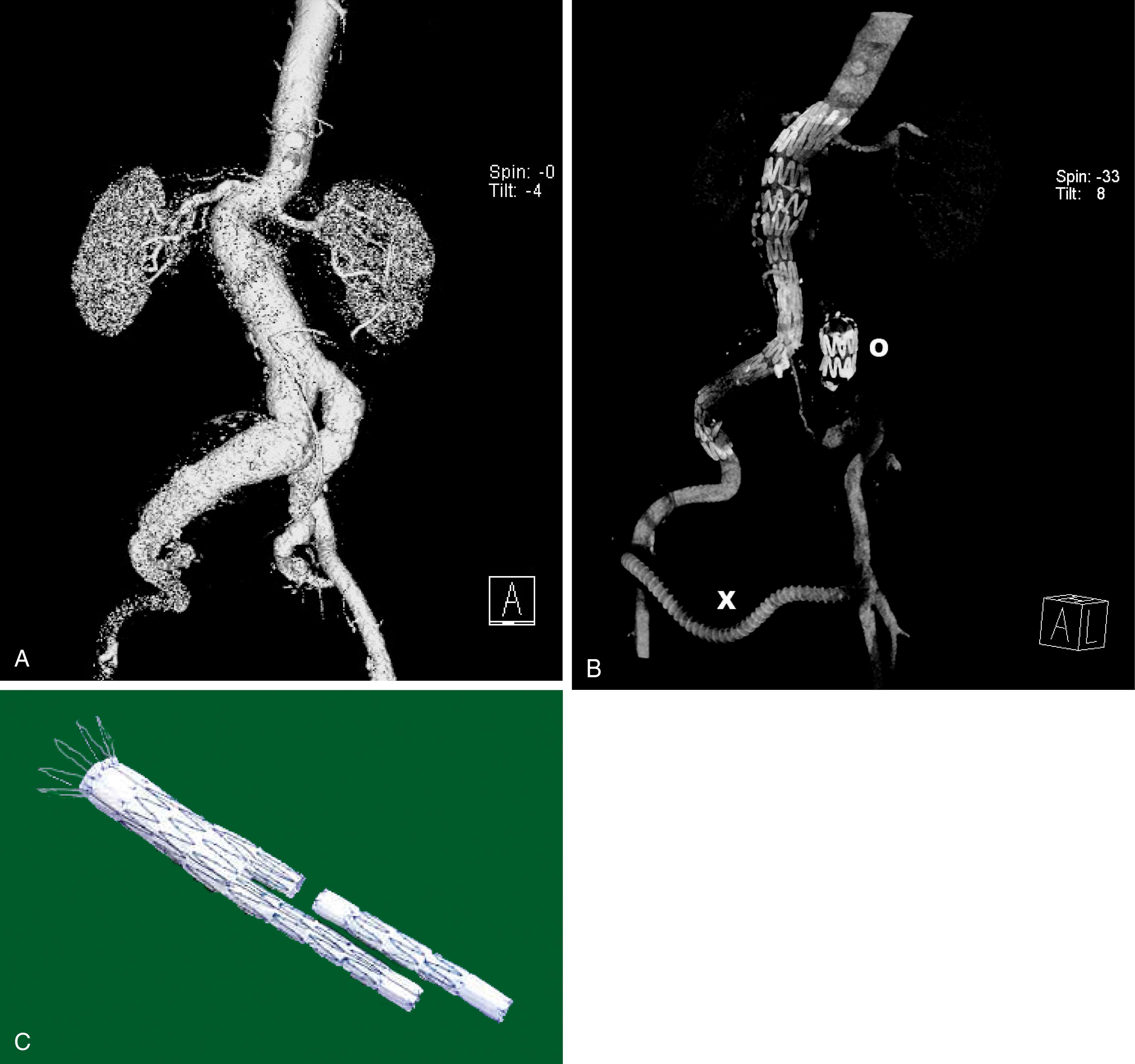Physical Address
304 North Cardinal St.
Dorchester Center, MA 02124
An aneurysm is defined as a localised area of pathological arterial dilatation. For the abdominal aorta, an anteroposterior diameter of ≥3 cm is generally accepted as defining an aneurysm. In some patients with aneurysmal disease, all major arteries are wider (arteriomegaly) and one or more becomes truly aneurysmal. Aneurysms of the abdominal aorta and the iliac, femoral and popliteal arteries are often branded ‘atherosclerotic’ but the primary disorder is degeneration of the elastin and collagen of the arterial wall. Atherosclerosis that can be found within aneurysms is not causative; it is likely that the two pathologies share risk factors. Aneurysms are relatively uncommon; found mainly in males over 70 years of age, they are even less common in women, in whom they present about 10 years later. At least a quarter of patients have more than one aneurysm.
| Clinical Presentation | Pathophysiology |
|---|---|
| Asymptomatic —discovered incidentally as pulsatile mass in abdomen, groin or popliteal fossa, on abdominal x-ray, CT or ultrasound scan | Progressive aneurysmal dilatation. May be self-limitingif hypertension and smoking controlled |
| Symptomatic —abdominal or back pain with tender aneurysm. Needs urgent surgery | Rapidly expanding aneurysms cause pressure on adjacent structures |
| Sudden death —acute, usually fatal, cardiovascular collapse. Often misdiagnosed as myocardial infarction | Sudden rupture of aneurysm only detected at autopsy or in the dissection room (or not at all) |
| Leaking/ruptured aneurysm —ill-defined back or abdominal pain often simulating ureteric colic or other abdominal emergency. Diagnostic if accompanied by transient collapse. Sometimes a history of recent similar episodes. Pulsatile abdominal mass palpable in 50% | Dilatation and thinning of the wall of an aneurysm leading to leakage of blood into retroperitoneal tissues—usually leads to catastrophic rupture within hours |
| Symptoms and signs of acute severe leg ischaemia ; often pulsatile popliteal aneurysm on contralateral side | Sudden thrombotic occlusion of aneurysmal popliteal artery |
| Complete arterial occlusion —sudden distal ischaemia affecting lower limb caused by embolism of thrombus from within aneurysm | Thrombotic occlusion of popliteal artery |
| Screening —discovered on population screening or opportunistic screening for aneurysm |
Degenerative aneurysms are usually fusiform , slowly expanding in diameter. As it enlarges, the vessel wall thins, expansion accelerates and the risk of rupture increases. Most abdominal aortic aneurysms (AAAs) involve only the infrarenal aorta; some extend distally to involve common iliac arteries; sometimes there are separate aneurysms of internal iliac arteries ( Fig. 42.1 ). A few extend proximally to become thoracoabdominal aneurysms .

Aortoiliac aneurysms are often found incidentally . The patient may notice a pulsatile abdominal mass or a pulsatile mass may be discovered on abdominal examination. An aneurysm may also be noticed incidentally on radiological investigation—as calcification on a plain abdominal x-ray, as an obvious aneurysm on computed tomography (CT) or, most commonly, on ultrasound scanning for obstructive urinary symptoms (see Fig. 42.2 ). More recently in the United Kingdom, a national AAA screening programme has been implemented, with the aim of offering all men an abdominal aortic ultrasound scan on reaching 65 years.
Despite screening, a proportion of cases that reach surgeons present because of symptoms of retroperitoneal leakage or rupture . This carries a very high mortality. Several studies have shown that the total community and hospital mortality after rupture is more than 75%, whereas elective treatment can have a mortality rate of less than 5%. Pain is the most common symptom of a leaking aneurysm. The patient often gives a history of transient or persistent cardiovascular collapse (fainting, hypotension), which should alert clinicians to the probable diagnosis. The clinical picture ranges from an ‘acute abdomen’ to abdominal or back pain of up to a week’s duration, and the diagnosis is usually confirmed by finding a pulsatile abdominal mass. Sometimes the symptoms can mimic renal colic or back pain, so an AAA must be excluded in all older men presenting with such symptoms. Intraperitoneal rupture and often extraperitoneal rupture are rapidly fatal and can be an unrecognised cause of sudden death in the elderly, with the cause often attributed to myocardial infarction.
Femoral and popliteal aneurysms are relatively uncommon and usually present as pulsatile masses. The larger they become, the more likely complications are to ensue. Femoral aneurysms occasionally rupture causing pain and massive swelling in the groin. Popliteal aneurysms are liable to undergo thrombosis or embolise, causing an acutely ischaemic leg ( Table 40.2 ). A thrombosed popliteal aneurysm carries a 50% risk of limb loss. In any patient presenting with an acutely ischaemic leg, it is vital to exclude this diagnosis as successful treatment will require extensive surgery (often a bypass graft). Popliteal aneurysms can occasionally rupture and cause a variety of other presentations listed in Table 40.2 .
For asymptomatic aneurysms, the risk of rupture increases almost exponentially as the aneurysm dilates. Most vascular surgeons would consider operating on abdominal or thoracic aortic aneurysms of 5 to 5.5 cm or more, or those that expand more than 0.5 cm a year; 6 cm is generally considered to be critical, since 40% of such aneurysms can be expected to rupture over the following 2 years.
If there are symptoms , such as back pain or abdominal pain, or signs of tenderness that can be attributed to the aneurysm, imminent rupture must be assumed and urgent operation performed.
A leaking or ruptured AAA is a surgical emergency. Less than half the patients reach hospital alive, and only about half of those undergoing surgery survive. The majority of patients die of shock before reaching the operating theatre or else of myocardial infarction or acute renal failure after operation. The true mortality of rupture is thus more than 75%. On the other hand, the mortality after elective operation or endovascular repair (endovascular aortic repair [EVAR], see p. 538) for aneurysm can be less than 5%. Thus the decision to operate electively on a known aneurysm depends on the estimated risk of rupture versus the risk of elective intervention. Indications for operation are summarised in Box 42.1 .
Leaking or ruptured aneurysms —if patient’s state and general fitness permit
Symptomatic aneurysms —aneurysms causing pain (particularly if tender), ureteric obstruction or embolism
Expanding aneurysms —aneurysms that enlarge at a rate of more than 0.5 cm in 1 year
Size —most arterial surgeons now recommend operation on aneurysms of 5.5 cm diameter or greater, or any saccular aneurysm
For asymptomatic aneurysms considered too small to warrant operation, ultrasonography is used for periodic monitoring , with referral to a surgeon once the size reaches an index diameter (usually 5 or 5.5 cm) or is seen to expand more than 0.5 cm in a year.
Where elective operation is planned, CT scanning is used to show the relationship of the aneurysm to the renal arteries; the 5% of cases, where the aneurysm extends above the renal arteries, require a thoracoabdominal operative approach and the operation carries a greater risk. CT can also show if iliac arteries are aneurysmal and if the aneurysm is inflammatory (i.e., has a thick layer of inflammatory tissue on its anterior surface that makes surgery technically difficult). Representative CT slices are usually taken through the chest to ensure the thoracic aorta is not aneurysmal; if there is a thoracic aneurysm , the management plan will have to accommodate it, according to size and position. If an aneurysm patient requiring surgery also has evidence of lower limb ischaemia , some form of arteriography is usually necessary, in case a combined reconstruction is required.
Any patient with a suspected leaking or ruptured AAA should be treated as a true surgical emergency, but not necessarily by immediate transfer to the nearest operating theatre. There is good evidence that the survival rate increases when ruptured AAAs are treated by a specialist team of surgeons and anaesthetists, and this may mean transfer to a vascular centre. Overaggressive blood pressure resuscitation of the hypotensive patient may convert a stable, contained leak into a free rupture, and many clinicians support the use of permissive hypotension to facilitate transfer (see Ch. 15 ), that is, not treating relative hypotension, whilst the patient remains conscious and free from cardiac symptoms. This principle has increased the time available for transfer and/or further investigation.
Provided the patient with a leaking AAA is not demonstrating signs of gross cardiovascular instability, a CT scan can be valuable in planning treatment by demonstrating how the aneurysm relates to renal and visceral arteries and showing any secondary
iliac aneurysms; sometimes other abdominal pathology is shown that influences the decision to operate, for example, liver metastases. In units equipped to undertake emergency EVAR (see later), CT can show whether this is possible.
The dilated aneurysmal segment is surgically corrected by means of a graft. Over recent years, there has been a trend towards treating AAAs using minimally invasive stent-graft placement (EVAR) via the femoral artery. Many patients still, however, undergo open surgery. The indications and relative merits of each technique are shown in Table 42.2 . Tube grafts or bifurcation grafts of synthetic material (usually Dacron) are used for aortoiliac and femoral aneurysms, whilst autogenous saphenous vein is preferred for popliteal aneurysms.
| Conventional Surgery | Endovascular Therapy | |
|---|---|---|
| Mortality related to procedure | Approximately 3%–5% | 1.7% |
| Length of hospital stay | 7–14 days | 1–2 days |
| ITU/HDU care needed | Likely | Unlikely |
| Anatomical constraints | Distance between AAA and renal arteries can be less than 15 mm | Needs 10–15 mm of relatively normal aorta below renals |
| Past medical history | More difficult with previous surgery or peritonitis | Unaffected by previous abdominal surgery |
| Follow up | Discharge at 3 months. Rescan after 5–7 years. Reintervention unlikely | Frequent CT and ultrasound for life. Reintervention rates high but improving |
For abdominal aneurysms, the standard open approach is a long midline or a transverse abdominal incision. The aorta is usually reached via the peritoneal cavity or sometimes via an extraperitoneal approach. The patient is usually anticoagulated perioperatively, with intravenous heparin, to prevent distal thrombosis, and the iliac arteries and the infrarenal aorta are clamped ( Fig. 42.4 ). The aneurysm is incised longitudinally and any clot within it removed. Bleeding lumbar arteries opening into the posterior aortic wall are closed with sutures.


Proximally, the graft is sutured just above the upper limit of the aneurysm to (relatively) normal aortic wall within the aneurysmal sac, and to the native aorta, at the bifurcation within the sac distally. Sometimes a bifurcated (‘trouser’) graft is used in aortoiliac aneurysmal disease, with the distal graft ends sutured to an area of normal iliac artery. The aneurysm sac is left in situ and later closed around the graft. This is known as inlay grafting : it allows separation of the graft from the intestine, reducing the risk of an aortointestinal fistula arising later from the graft anastomoses.
EVAR is a minimally invasive technique using combined stent-grafts. In the United Kingdom, the National Institute for Care and Health Excellence has approved it, but recommends that clinicians ensure patients fully understand the long-term uncertainties and potential complications, including endovascular leaks, the possibility of secondary intervention and the need for lifelong follow up.
Most cases are performed under general anaesthesia, but many can be done under local anaesthesia. The procedure is performed in an operating theatre using a mobile x-ray image intensifier or in a specialist endovascular suite. The stent-graft consists of a self-expanding metal framework with a nonporous cloth covering; it is supplied in a constrained state within a sheath, which measures around 8 mm in diameter. When in situ, the main body of the device resembles a pair of trousers with one short leg.
Short transverse incisions are used to access common femoral arteries in the groin, but the procedure can also be performed totally percutaneously, without groin incisions, and using specially made closure devices for the arteriotomies, at the end of the procedure. The main device is passed into one femoral artery and guided proximally using radiological guidance to its position below the renal arteries. An angiogram checks the device can release below the renals. The constraining mechanism is then removed and the stent opens and expands against the vessel wall. The contralateral femoral artery is then exposed and a guidewire passed proximally to enter the main graft body, through the short leg. The second limb of the stent-graft is then completed by passing another covered stent over the guidewire and securing it into the main graft body and the iliac artery. After completion, the device looks like a complete pair of trousers and extends from the renal arteries to the common iliacs.
Open surgical repair of thoracic aneurysms carries a mortality of 10% to 20% and a high morbidity, but many can be repaired by EVAR using just two small groin incisions. Even ruptured aneurysms (abdominal or thoracic) can often be repaired using this technique, often using local anaesthesia. Incomplete traumatic aortic transsections have also been successfully treated with endovascular therapy. Advances continue to be made in EVAR technology so that more complex cases can be managed via this route, including the use of custom-made fenestrated EVAR grafts (FEVAR). These allow juxta- and suprarenal aneurysms to be treated, by creating windows in the EVAR, through which stents can be placed into renal and mesenteric arteries.
Become a Clinical Tree membership for Full access and enjoy Unlimited articles
If you are a member. Log in here